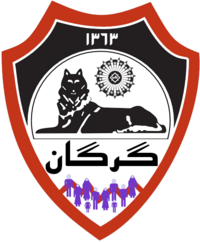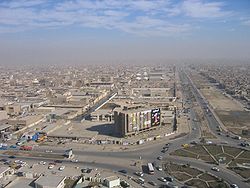Wolves (organisation)
| اذئاب Azab | |
|---|---|
 Emblem and shoulder patch of Azab members | |
| Leader | Adavazdar Samadani |
| Dates of operation | 19 June 1984–present |
| Country | |
| Active regions | Zorasan |
| Ideology | Sattarism |
| Political position | Right-wing |
| Size | ~1,150,000-3,500,000 |
| Annual revenue | ~$1.3 billion |
| Means of revenue | Union-Government of Zorasan |
Azab ("wolves") are irregular, pro-government Zorasani community organisations that support the Union-Government of Zorasan, the Nezzam and the national ideology of Sattarism. Initially created as popular mobilisation units, the Azab since their formal recognition in 1984, have become an integral tool in the political policing of local communities. The groups are known to be tasked with the implementation of public programs, such as child-care, food deliveries, building and road maintenance, but also the enforcement of morality laws, state repression and the harrassment of regime critics. The Azab have also been accused of extrajudicial killing at the behest of the government.
The Azab were initially created by local community groups during the 1970s to root out "national enemies" and to "spiritually mobilise the people" during the Irvadistan War (1975-1979), securing limited albeit vital government recognition and support. Following the war's end in 1979 and the subsequent completion of Zorasani unification in 1980, the groups remained active, steadily increasing their ties to the Zorasani military as it prepared to democratise the new country. On 19 June 1984, they were formally recognise as part of the Zorasani security apparatus and placed under the direct control of the Union Ministry of Internal Affairs. In 1986, the Azab were placed under the control of the Union Ministry for National Defence and ostensibly, military control. The Azab are organised as one "brigade" per urban district, though it is known that slum districts may operate two or more brigades depending upon criminality.
As of 2019, the Azab are believed to be number between 1.15 and 3.5 million strong, they receive basic training from law enforcement and the military on maintaining law and order, while many believe that the Azab have also been trained in the use of firearms and explosives. In 2013, it was revealed that the Azab brigades in Zahedan and Namrin had been distributed surveillance equipment.
History and background

The first reported "Azab Brigade" was formed in the slum district of Sattari in the Zorasani capital of Zahedan in 1972. It took the form of a popular community group, dedicated to refuse collection, simple road and building maintenance, as well as sporadic cases of vigilantism. The Sattari brigade was swiftly copied in other poor areas of Zahedan, before brigades began to be formed in other major cities across the Union of Khazestan and Pardaran. The brigades were usually formed by local reservists or active serving soldiers, and quickly gained the attention of local young unemployed males. By 1975, there were an estimated 350 brigades in the UKP's cities, with 800,00 members, it was during this time that these popular and independent bodies began to form direct ties with the central government and security services.
Despite initial calls for their formal inclusion in the state, UKP leader Javad Jahandar refused, citing his appreciation that they were "independent local bodies forged in our national ideology." However, many brigades had overt ties to local security services and politicians. From the 1970s onward, the relationship between the Azab brigades and the central government soldified and became more regimented and top-down, with the entire structure effectively subordinated to the orders and management of the government even before its formal absorbtion into the Union Ministry for National Defence.
The Azab came to national prominence during the Irvadistan War, where they implemented the government's Spiritual Mobilisation campaigns, organising patriotic and revolutionary rallies, recruitment drives and more nefariously, hunting down suspected "defeatists and traitors", common terms used to describe those who criticised the war, the death toll and economic struggles. Throughout the war, the Azab were noted for publicly humiliating war critics, while others were killed and their bodies dumped in public spaces with banners hung from their bodies, decrying defeatism. Between 1977 and 1979, the Azab were also tasked with the distribution of printed propaganda and the celebratory decorations delivered to the homes of martyred soldiers. During the war, an overwhelming majority of Azab brigades were comprised of above-military age males and school-age boys. The government during and after the war lauded the Azab as "key to the militarisation and mobilisation of the Union."
Following the Irvadistan War and the unification of Zorasan, Azab brigades were established in Irvadistan within months of its annexation into the new Union of Zorasani Irfanic Republics. It was revealed in the early 2000s, that many of the Azab brigades in Irvadistan were created using demobilised Badawiyan soldiers from Khazestan and Ajad, where they would intermix with the locals more sufficiently than those from Pardaran. This revelation aided civil society groups during the Saffron period to explain the high number of suspected extrajudicial killings in Irvadistan following its defeat and annexation in 1980. It would take over a decade before local brigades began to appear outside of Qufeira. By the 1990s, there were over 200 Azab brigades in Irvadistan and their role in providing humanitarian assistance to wartorn Irvadistan was seen as a key cause for the relative success of "unification and reconiliation" undertook following Irvadistan's absorbtion in to the UZIR.
Today, the Azab brigades have taken are more law enforcement and militarised form. It is common for Azab brigades to now be based out of local Mazars, where they include males of all age groups. In 2006, several Azab brigades began to include women, who regularly took up roles organising local childcare programs funded by the state or federal government, while they also conducted charitable food donations for the poor and elderly, run simple public health campaigns and literacy projects. Under the Union-Ministry of National Defence, the Azabs were ordered to include women nationwide in 2009 and authorised the creation of "Azab Morality Squads", where men and women would enforce Esafkar laws on the street. Female Azab Morality Squads are known to enforce Irfanic dress codes, though this has been limited to only days of religious importance. In 2018, some Azab brigades helped with after-school programs, child care centers, puppet shows, drug rehabilitation, and sports programs; they also encouraged voting by going door to door and protect communities from criminals.
By 2019, some Azab brigades were suspected of engaging in criminality. A government investigation revealed that Azab brigades in the southern districts of Pardaran and the Union Republics of Samrin and Armavand were involved in drug trafficking and dealing, this followed an noted increase in gang violence over narcotics. The suspected brigades were arrested and dissolved by the UMND and replaced with local supporters of the regime, the government also announced new stricter regulations of the network and its activities.